 W
WThe history of Washington, D.C., is tied to its role as the capital of the United States. Originally inhabited by an Algonquian-speaking people known as the Nacotchtank, the site of the District of Columbia along the Potomac River was first selected by President George Washington. The city came under attack during the War of 1812 in an episode known as the Burning of Washington. Upon the government's return to the capital, it had to manage reconstruction of numerous public buildings, including the White House and the United States Capitol. The McMillan Plan of 1901 helped restore and beautify the downtown core area, including establishing the National Mall, along with numerous monuments and museums.
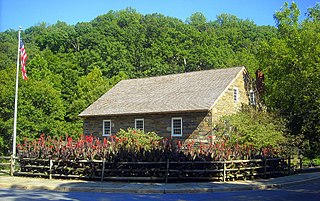 W
WThis is a list of properties and districts in the District of Columbia on the National Register of Historic Places. There are more than 600 listings, including 74 National Historic Landmarks of the United States and another 13 places otherwise designated as historic sites of national importance by Congress or the President.
 W
WFamily Research Council (FRC) is an American fundamentalist Protestant activist group, with an affiliated lobbying organization. Its stated mission is "to advance faith, family and freedom in public policy and the culture from a Christian worldview". FRC promotes what it considers to be family values by advocating and lobbying for policies in government.
 W
WAdas Israel, located in the Cleveland Park neighborhood, is the largest Conservative synagogue in Washington, D.C. President Ulysses S. Grant attended the dedication of its first building in 1876, the first time a sitting United States President had attended a synagogue service. The original structure is the oldest surviving synagogue building in Washington, D.C., and today the Lillian & Albert Small Jewish Museum.
 W
WThe Aqueduct Bridge was a bridge between Georgetown, Washington, D.C., and Rosslyn, Virginia. It was built to transport cargo-carrying boats on the Chesapeake and Ohio Canal in Georgetown across the Potomac River to the Alexandria Canal. The same eight piers supported two different bridges: a wooden canal bridge and an iron truss bridge carrying a roadway and an electric trolley line. The bridge was closed in 1923 after the construction of the nearby Key Bridge. The shuttered Aqueduct Bridge was demolished in 1933.
 W
WThe Reverend Stephen Bloomer Balch was a Presbyterian minister and educator in Georgetown, which is now part of Washington, D.C.. In 1780, Balch established Georgetown Presbyterian Church, which was the second church in Georgetown. He also served as headmaster of the Columbian Academy in Georgetown.
 W
WThe Baltimore and Potomac Railroad Station, also known as Pennsylvania Railroad Station, was a railroad station that was owned by the Pennsylvania Railroad and operated by the Baltimore and Potomac Railroad in Washington, D.C., from July 2, 1872 until its closure in 1907. It was located at the southern corner of 6th street NW and B Street NW, now the site of the West Building of the National Gallery of Art. It was in this train station that United States President James A. Garfield was assassinated by Charles Guiteau.
 W
WThe boundary markers of the original District of Columbia are the 40 milestones that marked the four lines forming the boundaries between the states of Maryland and Virginia and the square of 100 square miles (259 km²) of federal territory that became the District of Columbia in 1801. Working under the supervision of three commissioners that President George Washington had appointed in 1790 in accordance with the federal Residence Act, a surveying team that Major Andrew Ellicott led placed these markers in 1791 and 1792. Among Ellicott's assistants were his brothers Joseph and Benjamin Ellicott, Isaac Roberdeau, George Fenwick, Isaac Briggs and an African American astronomer, Benjamin Banneker.
 W
WBuzzard Point is an urbanized area located on the peninsula formed by the confluence of the Potomac and Anacostia Rivers in the southwest quadrant of Washington, D.C., United States.
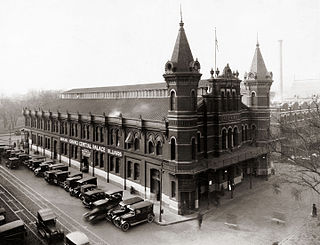 W
WCenter Market was a market hall in Washington, D.C. designed by architect Adolph Cluss which operated in Washington, DC from 1872 to 1931. The building was demolished in 1931 to be replaced by the National Archives Building. A market called Center Market had been in operation on the same block of land since 1802. In 1931, the name of Center Market was transferred over to the Northern Liberty Market located a few blocks north.
 W
WCityCenterDC is a mixed-use development consisting of two condominium buildings, two rental apartment buildings, two office buildings, a luxury hotel, and public park in downtown Washington, D.C. It encompasses 2,000,000 square feet (190,000 m2) and covers more than five city blocks. The $950 million development began construction on April 4, 2011, on the site of the former Washington Convention Center—a 10.2-acre (4.1 ha) site bounded by New York Avenue NW, 9th Street NW, H Street NW, and 11th Street NW. Most of the development was completed and open for business by summer 2015. The luxury hotel Conrad Washington, DC, opened in February 2019.
 W
WColumbian Harmony Cemetery was an African-American cemetery that formerly existed at 9th Street NE and Rhode Island Avenue NE in Washington, D.C., in the United States. Constructed in 1859, it was the successor to the smaller Harmoneon Cemetery in downtown Washington. All graves in the cemetery were moved to National Harmony Memorial Park in Landover, Maryland, in 1959. The cemetery site was sold to developers, and a portion used for the Rhode Island Avenue – Brentwood Washington Metro station.
 W
WCoxey's Army was a protest march by unemployed workers from the United States, led by Ohio businessman Jacob Coxey. They marched on Washington, D.C. in 1894, the second year of a four-year economic depression that was the worst in United States history to that time. Officially named the Army of the Commonwealth in Christ, its nickname came from its leader and was more enduring. It was the first significant popular protest march on Washington, and the expression "Enough food to feed Coxey's Army" originates from this march.
 W
WThe Washington, DC Admission Act, often referred to simply as the DC Admission Act, is a bill introduced during the 116th United States Congress. The intention of the bill is to grant Washington, DC admission into the Union as a state. The bill was originally introduced in the 116th Congress on January 3, 2019, and was resubmitted on January 4, 2021 in the 117th Congress.
 W
WDistrict Grocery Stores (DGS) was a cooperative of small single-room grocery stores in Washington, DC, Maryland and Northern Virginia. It operated from 1921 to 1972. The goal was to leverage the volume of purchasing power of the cooperative to negotiate better prices from wholesalers and therefore improve their competitiveness. The cooperative started with 20 members to grow to 300 members at its peak, most of whom were Jewish immigrant families from Europe. The stores were located across the Washington metropolitan area.
 W
WAndrew Ellicott was an American land surveyor who helped map many of the territories west of the Appalachians, surveyed the boundaries of the District of Columbia, continued and completed Pierre (Peter) Charles L'Enfant's work on the plan for Washington, D.C., and served as a teacher in survey methods for Meriwether Lewis.
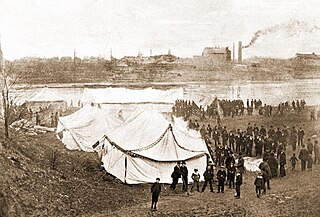 W
WFry's Army was the informal name given to a short-lived radical protest movement organized in Los Angeles, California in 1894 and headed by trade union and socialist political activist Lewis C. Fry. Fry's Army was one of about 40 "Industrial Armies" formed in 1894 to organize and transport unemployed workers for a march on Washington, D.C., the best remembered of which was the Ohio-based movement known as Coxey's Army.
 W
WThe Garden Club of America Entrance Markers in Washington, D.C. is a Multiple Property Submission, or MPS, on the National Register of Historic Places. The seven structures that make up the MPS are ceremonial markers at important entrance points to the District of Columbia from the state of Maryland. Sets of two markers are located in Westmoreland Circle, Friendship Heights and Chevy Chase Circle. A single marker is located along Georgia Avenue.
 W
WJames A. Garfield, the 20th President of United States, was fatally shot at the Baltimore and Potomac Railroad Station in Washington, D.C., at 9:30 am on July 2, 1881. He died in Elberon, New Jersey, 79 days later on September 19, 1881. The shooting occurred less than four months into his term as president. His assassin was Charles J. Guiteau, whose motive was revenge against Garfield for an imagined political debt. Guiteau was convicted of Garfield's murder and executed by hanging one year after the shooting.
 W
WThe Georgetown street renaming occurred as a result of an 1895 act of the United States Congress that ended even the nominal independence of Georgetown from Washington, D.C. The Act required, inter alia, that the street names in Georgetown be changed to conform to the street-naming system in use in the Northwest quadrant of Washington, D.C. However, the old street names were shown on maps as late as 1899.
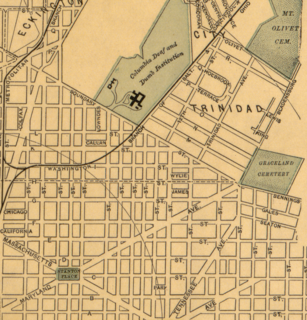 W
WGraceland Cemetery was a 30-acre (120,000 m2) cemetery located in the Carver Langston neighborhood of Washington, D.C., in the United States. It was founded in 1871 as a privately owned secular cemetery open to the public, but it primarily served the city's African American community. From 1884 to 1885, more than 1,200 bodies were transferred to Graceland Cemetery from Holmead's Burying Ground. When the cemetery encountered financial problems, the owners attempted to sell the land. This led to a lengthy and bitter battle involving the Graceland Cemetery Association, lotholders, the government of the District of Columbia, and the United States Congress. Graceland Cemetery closed by an Act of Congress on August 3, 1894. Removal of remains was also bitterly contested, but a court ruled in the summer of 1895 that the lotholders did not have the right to prevent their removal. Most of the bodies at Graceland were reinterred at Woodlawn Cemetery in Washington, D.C.
 W
WThe Historical Society of Washington, D.C. is an educational foundation and museum dedicated to preserving and displaying the history of Washington, D.C. The society provides lectures, exhibits, classes, community events, and other educational programs as part of its mission. In addition, the society's Kiplinger Research Library houses a collection of books, maps, photographs, and other materials relevant to the history of the city.
 W
WHoover Field was an early airport serving the city of Washington, D.C. It was constructed as a private airfield in 1925, but opened to public commercial use on July 16, 1926. It was located in Arlington, Virginia, near the intersection of the Highway Bridge and the Mount Vernon Memorial Parkway, where The Pentagon and its northern parking lots now stand.
 W
WJames Creek was a tributary of the Anacostia River in the southwest quadrant of Washington, D.C., once known as St. James' Creek and perhaps named after local landowner James Greenleaf.
 W
WThe L'Enfant Plan for the city of Washington is the urban plan developed in 1791 by Major Pierre (Peter) Charles L'Enfant for George Washington, the first President of the United States.
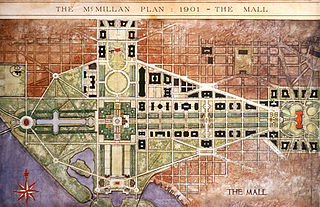 W
WThe McMillan Plan is a comprehensive planning document for the development of the monumental core and the park system of Washington, D.C., the capital of the United States. It was written in 1902 by the Senate Park Commission. The commission is popularly known as the McMillan Commission after its chairman, Senator James McMillan of Michigan.
 W
WMcMillan Sand Filtration Site is a twenty-five acre decommissioned water treatment plant in northwest Washington, D.C., built as part of the historic McMillan Reservoir Park. It is bound on the north by Michigan Avenue, on the east by North Capitol Street, on the south by Channing Street and on the west by McMillan Drive; which runs along the edge of the reservoir, to which it was formerly attached. Two paved courts lined by regulator houses, tower-like sand bins, sand washers and the gated entrances to the underground filter cells provided a promenade for citizens taking the air in the park before it was fenced off in WWII.
 W
WMcPherson Square is a square in downtown Washington, D.C. It is bound by K Street Northwest to the north, Vermont Avenue NW on the East, I Street NW on the south, and 15th Street NW on the West; it is one block northeast of Lafayette Park. It is served by the McPherson Square station of the Washington Metro.
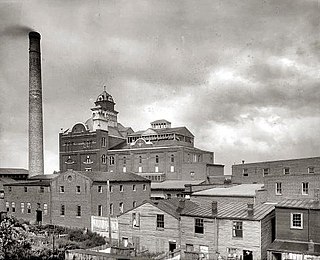 W
WThe National Capital Brewing Company was founded in 1890 by Albert Carry and Robert Portner, two successful Washington, D.C. area brewers. The brewery could produce 100,000 barrels of beer a year and was considered state-of-the-art for the time. It replaced a previous brewery which operated on the site since at least 1877.
 W
WThe National Republican (1860–1888) was an American, English-language daily newspaper published in Washington, D.C.
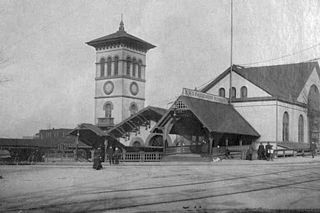 W
WThe Washington Depot or New Jersey Avenue Station was a train station located in Northwest Washington, D.C., a block north of the Capitol. The train station was also called the B&O Depot as it was served by the Baltimore & Ohio Railroad. It operated from April 1851 until October 26, 1907, when Union Station commenced operation. During the American Civil War, the New Jersey Avenue Station was the major embarkation site for hundreds of thousands of Union troops. President Abraham Lincoln arrived there to be sworn in as President in 1861. It was from that station that his body along with his son "Willie" Lincoln began its long journey to his final resting place in Illinois after he was assassinated on April 14, 1865.
 W
WThe Norfolk & Washington Steamboat Company was a steamboat company that transported passengers and freight between Washington, DC and Norfolk, Virginia on the Potomac River.
 W
WThe Northern Liberty Market, later called Convention Hall Market and Center Market, was located on the east side of 5th Street NW, between K and L, in the present-day Mount Vernon Triangle neighborhood of Washington, D.C. It operated from 1875 to 1963.
 W
WThe Old Greyhound Terminal was a bus terminal serving Greyhound Lines located at 1100 New York Avenue NW in Northwest, Washington, D.C. in the United States operating from 1940 to the 1980s. It was used extensively during World War II to transport servicemen, and played a minor role in the Civil Rights Movement. It was saved through the intervention of preservationists. Most of the building was incorporated in the new 1100 New York Avenue high-rise office building when it was built in 1991.
 W
WThe Pearl incident was the largest recorded nonviolent escape attempt by people in slavery in United States history. On April 15, 1848, seventy-seven enslaved people attempted to escape Washington D.C. by sailing away on a schooner called The Pearl. Their plan was to sail south on the Potomac River, then north up the Chesapeake Bay and Delaware River to the free state of New Jersey, a distance of nearly 225 miles (362 km). The attempt was organized by both abolitionist Whites and free Blacks, who expanded the plan to include many more enslaved. Paul Jennings, a former enslaved who had served President James Madison, helped plan the escape.
 W
WPotomac Yard is a neighborhood in Northern Virginia that straddles southeastern Arlington County and northeastern Alexandria, Virginia, located principally in the area between U.S. Route 1 and the Washington Metro Blue Line /Yellow Line tracks. The area was home to what was once one of the busiest rail yards on the Eastern Seaboard of the United States. The "Potomac Yard" name is also used to refer to several developments in the area, especially the Potomac Yard Retail Center strip mall and a planned Washington Metro rail station.
 W
WPresidential Airways was an airline with its headquarters on the grounds of Washington Dulles International Airport in Northern Virginia. It was founded in 1985 by Harold J. (Hap) Pareti, formerly an officer at People Express Airlines, known as PEOPLExpress a low-cost carrier, with Boeing 737-200 service from Washington Dulles to Boston Logan in Massachusetts commencing October 10 of that year. A small fleet of B737-200 jetliners were initially operated by the airline.
 W
WThe Residence Act of 1790, officially titled An Act for establishing the temporary and permanent seat of the Government of the United States, is a United States federal statute adopted during the second session of the First United States Congress and signed into law by President George Washington on July 16, 1790. The Act provides for a national capital and permanent seat of government to be established at a site along the Potomac River and empowered President Washington to appoint commissioners to oversee the project. It also set a deadline of December 1800 for the capital to be ready, and designated Philadelphia as the nation's temporary capital while the new seat of government was being built. At the time, the federal government was operating out of New York City.
 W
WRiggs Bank was a bank headquartered in Washington, D.C. For most of its history, it was the largest bank headquartered in that city. On May 13, 2005, after the exposure of several money laundering scandals, the bank was acquired by PNC Financial Services.
 W
WMichael G. Shiner (1805–1880) was an African-American Navy Yard worker and diarist who chronicled events in Washington D.C. for more than 60 years, first as a slave and later as a free man. His diary entries have provided historians a first hand account of the War of 1812, the British Invasion of Washington, the burning of the U.S. Capitol and Navy Yard, and the rescue of his family from slavery as well as shipyard working conditions, racial tensions and other issues and events of 19th century military and civilian life.
 W
WThe District of Columbia statehood movement is a political movement that advocates making the District of Columbia a U.S. state to provide the taxpayers of the District of Columbia with voting representation in the Congress and full control over local affairs.
 W
WThe 1978 Washington summit was the 5th NATO summit bringing the leaders of member nations together at the same time. The formal sessions and informal meetings in Washington, D.C. took place on May 30–31, 1978. This event was only the fifth meeting of the NATO heads of state following the ceremonial signing of the North Atlantic Treaty on April 4, 1949.
 W
WSwampoodle Grounds aka Capitol Park (II) was the home of the Washington Nationals baseball team of the National League from 1886 to 1889. The name refers to the one-time Swampoodle neighborhood of Washington.
 W
WThe Three Sisters Bridge was a planned bridge over the Potomac River in Washington, D.C., with piers on the Three Sisters islets. Envisioned in the 1950s and formally proposed in the 1960s, it was cancelled amid protests in the 1970s.
 W
WTiber Creek or Tyber Creek, originally named Goose Creek, is a tributary of the Potomac River in Washington, D.C. It was a free-flowing creek until 1815, when it was channeled to become part of the Washington City Canal. Presently, it flows under the city in tunnels, including under Constitution Avenue NW.
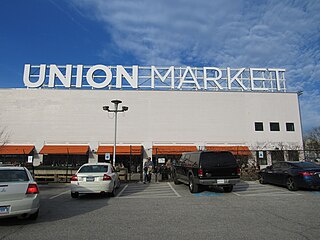 W
WUnion Market was formally known as Union Terminal Market when it started as a replacement market center for the old Center Market located near the mall in 1931. It became an important part of the Washington food infrastructure to feed a growing city population. It featured retail and wholesales stores as well as a farmers' market which ran into trouble with the city in the 1960s due to its failure to comply with sanitation and safety standards. A new building was completed in 1967 to replace it and is today the food hall carrying the name "Union Market". After falling in disrepair in the 1980s and 1990s, the area is being revived as a hip destination for restaurant and night life near NoMa and H Street. While for many it is a specific building containing the gourmet food hall, it is in fact an area that today features restaurants, a small movie theater, an ice cream factory and new luxury apartment buildings in Northeast Washington, D.C. off of Florida Avenue NE. These new venues are slowly replacing the old stores that had been the heart and soul of the market.
 W
WWashington Airport was the second major airport to serve the city of Washington, D.C., in the United States. Located in Arlington, Virginia, near the intersection of the Highway Bridge and the Mount Vernon Parkway. The first airport to serve the city was Hoover Field, a private airfield constructed in 1925. Washington Airport, a private airport triple the size of Hoover Field, was built literally across the road in late 1927. The airfield suffered from short and unpaved runways, numerous life-threatening obstructions around the field, poor visibility, and poor drainage. Washington Airport nearly went bankrupt in 1933, and it was auctioned off to a new owner. The new owner also owned Hoover Field, and merged the two into a single airfield, Washington-Hoover Airport.
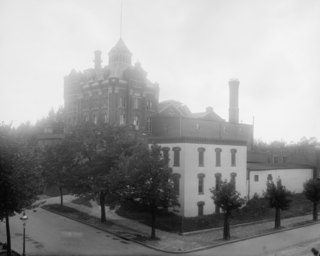 W
WThe Washington Brewery Company was a beer brewery in Washington, DC. It operated from 1890 to 1917 on Square 811.
 W
WThe Washington City Canal operated from 1815 until the mid-1850s in Washington, D.C. The canal connected the Anacostia River, termed the "Eastern Branch" at that time, to Tiber Creek, the Potomac River, and later the Chesapeake and Ohio Canal (C&O). The canal became disused during the late 19th century and the city government covered over or filled in various sections in 1871.
 W
WThe 1982 Washington Metro train derailment was an incident involving a single Orange Line Washington Metro train during the afternoon rush hour of January 13, 1982, in Downtown Washington, D.C. in the United States. The train derailed as it was being backed up from an improperly closed rail switch between the Federal Triangle and Smithsonian stations, and caused the deaths of three passengers. Several survivors were trapped for hours, and 25 were injured. The incident was the first resulting in a fatality involving the Metro system and remained as the deadliest incident occurring in the system until the June 22, 2009 collision that resulted in nine fatalities.
 W
WThe Washington Star, previously known as the Washington Star-News and the Washington Evening Star, was a daily afternoon newspaper published in Washington, D.C. between 1852 and 1981. The Sunday edition was known as the Sunday Star. The paper was renamed several times before becoming Washington Star by the late 1970s. For most of that time, it was the city's newspaper of record, and the longtime home to columnist Mary McGrory and cartoonist Clifford K. Berryman. On August 7, 1981, after 128 years, the Washington Star ceased publication and filed for bankruptcy. In the bankruptcy sale, The Washington Post purchased the land and buildings owned by the Star, including its printing presses.
 W
WWashington-Hoover Airport was an airport serving the city of Washington, D.C., in the United States from 1933 to 1941. It was created by the merger of Hoover Field and Washington Airport on August 2, 1933. It was in Arlington, Virginia, near the intersection of the Highway Bridge and the Mount Vernon Memorial Highway. Washington-Hoover Airport, like its predecessors, suffered from safety problems, short runways, and little room to grow. It closed for public use in June 1941, and the United States Department of War purchased the site in September, closing it for good. Washington National Airport, which opened in June 1941, was built as its replacement. The Pentagon now occupies the site.
 W
WExtensive measures are used to protect the White House as the official residence and office space of the President of the United States, and grounds. Security is primarily provided by the United States Secret Service. Despite security measures such as a fence, there have been some people who have managed to gain unauthorized access to the White House.